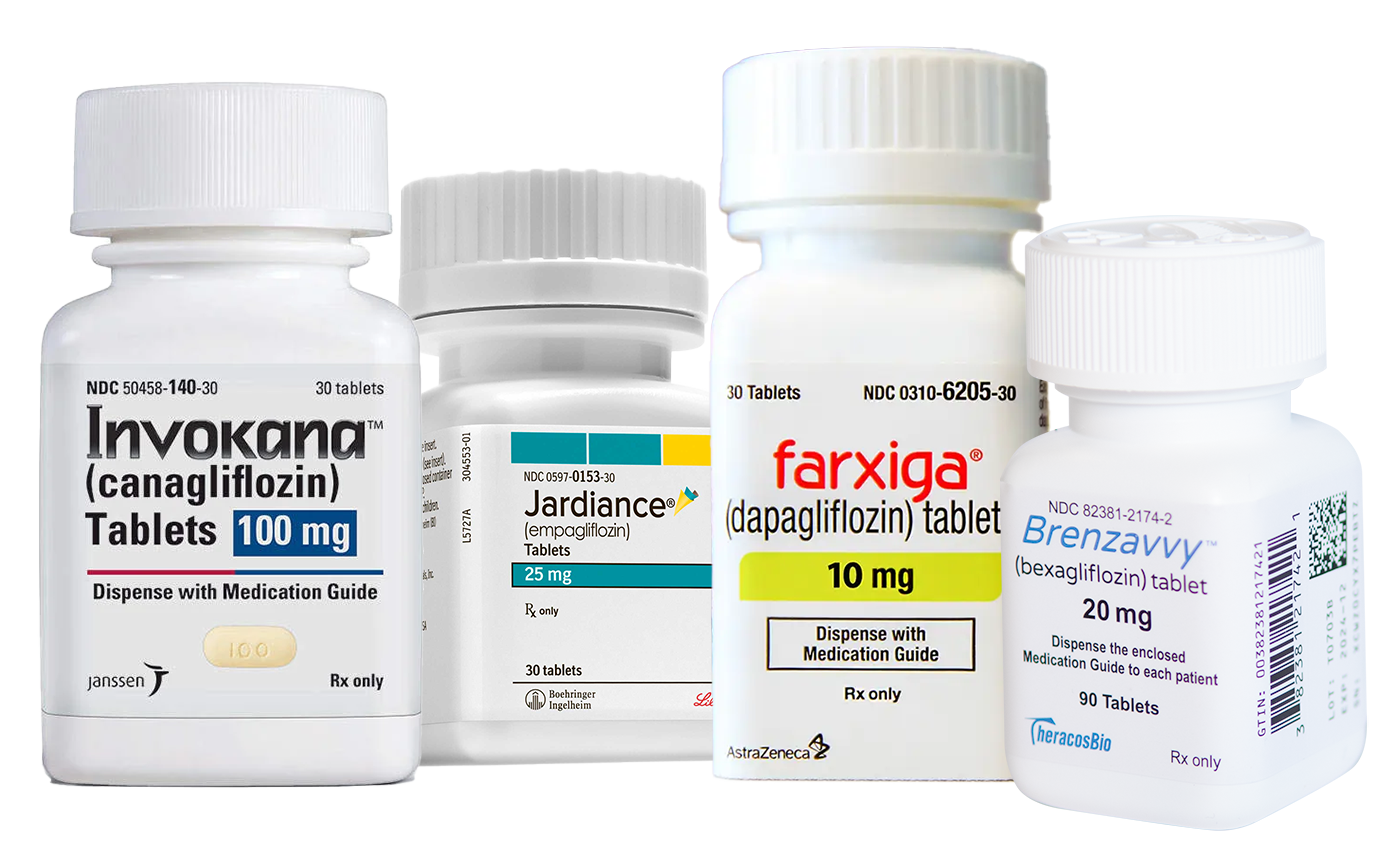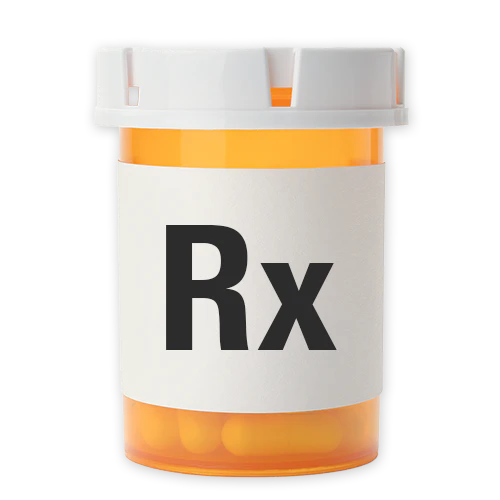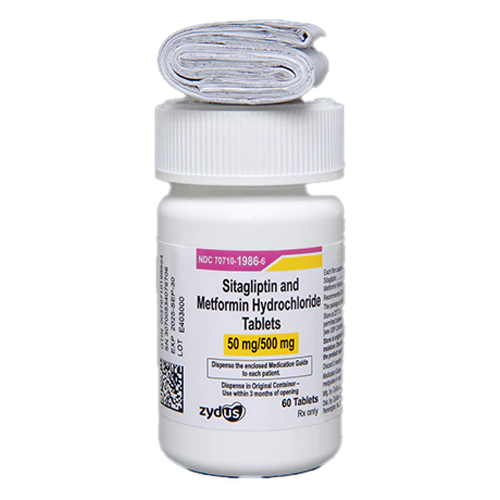Managing type 2 diabetes (T2D) often requires a multifaceted approach, combining lifestyle changes with medication when necessary. Typically, Metformin is prescribed when you’re diagnosed with T2D. When Metformin isn’t enough to lower your glucose to healthy levels, your doctor may suggest combination therapy.
With several medication classes available, each with its own history and unique benefits, it's important to understand the options to make informed treatment decisions. Because different drugs act in different ways to lower blood glucose levels, they may be used together to help meet your goals. For example, metformin and Sitagliptin (DPP-4 inhibitor) may be used together to help keep blood glucose levels at goal. That said, many combinations can be used.
Metformin: First-Line Treatment Option
| Metformin | |
|---|---|

 |
|
| Drug Class | Biguanides |
| Examples | Metformin |
| Retail Cost | $4–$15 |
| A1C Reduction | 1%–2%. Can provide additional reduction when combined with other medications. |
Metformin has been a mainstay in T2D management since its discovery in the 1920s. Its use expanded in the 1950s, and it gained widespread popularity in the 1990s due to its efficacy, safety profile, and affordability.
Metformin remains the first-line medication for T2D and is often prescribed as the initial therapy and may be combined with other medications as the disease progresses.
Metformin works on multiple levels to control blood sugar levels:
- Primarily reduces the amount of glucose produced by the liver
- Increases insulin sensitivity in muscle cells, which enhances glucose uptake from the bloodstream into muscles
- Reduces the absorption of glucose from the intestines
Common side effects of metformin include gastrointestinal symptoms like nausea and diarrhea. However, these usually improve over time and can often be managed with lifestyle modifications or changes in dosage.
Metformin is on our Wholesale Price List
- $37 for 180 tablets or $70 for 360 tablets
- Free shipping
Sulfonylureas: Stimulating Insulin Production
| Glipizide, Glyburide, Glimepiride | |
|---|---|
 |
Stimulate inisulin production in the pancrease. |
| Drug Class | Sulfonylureas |
| Examples | Glipizide, Glyburide, Glimepiride |
| Retail Cost | $6–$24 |
| A1C Reduction | 1%–2%. They may become less effective over time and can cause weight gain. |
Sulfonylureas gained popularity for their ability to stimulate insulin secretion from the pancreas to lower blood sugar levels.
These medications target beta cells in the pancreas. Sulfonylureas attach to certain receptors on these cells, which causes the cells to release more insulin into the bloodstream.
Sulfonylureas were once the mainstay of T2D treatment and remain widely prescribed today, especially as second-line agents when metformin alone is insufficient. However, their popularity has waned in recent years with the emergence of newer drug classes offering additional benefits.
Common side effects of sulfonylureas include hypoglycemia (low blood sugar), weight gain, and gastrointestinal upset. They may also carry a risk of cardiovascular events, particularly in high doses or in individuals with pre-existing heart conditions.
Glipizide, glyburide, and glimepiride are on our Wholesale Price List
- $37 for 180 tablets or $70 for 360 tablets
- Free shipping
SGLT-2 Inhibitors: Blocking Glucose Reabsorption
| BRENZAVVY, JARDIANCE, FARXIGA, INVOKANA | |
|---|---|
 |
Block glucose reabsorption in the kidneys and remove excess sugar through urine |
| Drug Class | Sodium-Glucose Co-Transporter-2 (SGLT-2) Inhibitors |
| Examples | BRENZAVVY (bexagliflozin) INVOKANA (canagliflozin), FARXIGA (dapagliflozin), JARDIANCE (empagliflozin) |
| Retail Cost | $520–$720 |
| A1C Reduction | 0.5%–1%. They also offer cardiovascular and renal benefits. Individual responses may vary. |

SGLT-2 inhibitors, such as BRENZAVVY, emerged in the 2010s as a new class of T2D medications. Unlike previous drug classes that primarily focus on insulin production or sensitivity, SGLT-2 inhibitors target glucose directly.
In our bodies, glucose is continuously filtered by the kidneys and then reabsorbed back into the bloodstream. SGLT-2 proteins, located almost exclusively in the kidneys, are responsible for about 90% of this glucose reabsorption.
SGLT-2 inhibitors reduce glucose reabsorption in the kidneys, leading to more glucose being excreted in the urine.
These medications have gained popularity in recent years, particularly for their cardiovascular and renal benefits beyond glycemic control. Clinical trials have demonstrated reductions in the risk of cardiovascular events and progression of kidney disease in individuals with T2D and established cardiovascular disease or chronic kidney disease.
The most common side effects of SGLT-2 inhibitors include an increased risk of genital and urinary tract infections, such as yeast infections in women and urinary tract infections in both men and women. Patients may also experience increased urination and thirst. Additionally, a mild to moderate decrease in blood pressure, potentially causing dizziness or fainting, is another common side effect.
Get BRENZAVVY (SGLT-2 inhibitor) for $59.95/month with free shipping exclusively through Marely Drug.
DPP-4 Inhibitors: Targeting Incretin Pathway
| JANUVIA, ZITUVIO, KOMBOLYZE, TRADJENTA | |
|---|---|
 |
Increase gut hormone levels (GLP-1 and GIP) to promote insuline release |
| Drug Class | Dipeptidyl Peptidase-4 (DPP-4) Inhibitors |
| Examples | JANUVIA, ZITUVIO (sitagliptin), KOMBOLYZE (saxagliptin), TRADJENTA (linagliptin) |
| Retail Cost | $550–$760 |
| A1C Reduction | 0.5%–1%. They are often used as secondline therapy to provide additional A1C reduction. |

DPP-4 inhibitors entered the T2D treatment landscape in the early 2000s. These drugs gained attention for their novel mechanism of action: they enhance body’s natural ability to lower glucose levels.
When we eat, our gut releases two hormones, GLP-1 and GIP. These hormones prompt the pancreas to release insulin, which helps lower blood sugar levels. However, the enzyme DPP-4 quickly inactivates these hormones, limiting their effectiveness. DPP-4 inhibitors block the DPP-4 enzyme, allowing GLP-1 and GIP to remain active longer and enhance insulin secretion.
DPP-4 inhibitors quickly gained popularity as second-line options. They are typically well-tolerated and have a low risk of causing hypoglycemia (low blood sugar) when used alone or in combination with metformin. While not as widely prescribed as metformin or sulfonylureas, DPP-4 inhibitors remain a popular choice due to their favorable side effect profile.
Side effects of DPP-4 inhibitors may include upper respiratory tract infections, headache, and nasopharyngitis. While generally well-tolerated, there may be a low risk of pancreatitis or joint pain.
Get generic Sitaglipin (DPP-4 inhibitor) for $80/month with free shipping exclusively through Marely Drug.
GLP-1 Receptor Agonists: A Newer Approach
| OZEMPIC, RYBELSUS, MOUNJARO, VICTOZA BYETTA | |
|---|---|
 |
Supplement GLP-1 (gut hormone) which promotes insulin secretion |
| Drug Class | Glucagon-Like Peptide-1 (GLP-1) Receptor Agonists |
| Examples | BYETTA (exenatide), VICTOZA (liraglutide), OZEMPIC & RYBELSUS (semaglutide), MOUNJARO (tirzepatide) |
| Retail Cost | $900–$1,300 |
| A1C Reduction | 1%–1.5%. They also promote weight loss |

The history of GLP-1 agonists dates back to their introduction in the early 2000s. Initially, their use was limited due to the inconvenience of daily dosing schedules and other practical considerations. However, the arrival of Ozempic in 2017 revolutionized this class of drugs with a once-weekly injection regimen.
GLP-1 agonists work by supplementing the body with a form of GLP-1 that is resistant to the enzyme DPP-4. Normally, DPP-4 quickly deactivates natural GLP-1, but the synthetic form used in these medications is not easily broken down. This resistance to DPP-4 allows GLP-1 to last longer in the gut, providing more sustained blood sugar control.
GLP-1 helps regulate blood sugar levels in several ways:
- Promotes insulin secretion
- Slows stomach emptying, which reduces the rate at which glucose enters the bloodstream
- Signals the brain that you’re full
Additionally, Rybelsus is the first and only oral medication (once daily) in this drug class. Approved in 2019, Rybelsus offers a convenient alternative to injections, addressing one of the primary concerns associated with GLP-1 agonist therapy.
Common side effects may include nausea, vomiting, diarrhea, and injection-site reactions. Rare side effects may include pancreatitis and thyroid tumors.
Compare Dibetes Medications
| DRUG CLASS | MEDICATIONS | A1C REDUCTION | COST | HOW IT WORKS |
|---|---|---|---|---|
| Biguanides | Metformin | 1–2% | $4–$15 | Reduce glocuse production in the liver. |
| Sulfonylureas | Glipizide
Glyburide Glimepiride |
1–2% | $6–$24 | Stimulate the pancreas to release more insulin |
| SGLT-2 Inhibitors | JARDIANCE
FARXIGA BRENZAVVY INVOKANA |
0.5–1% | $520–$720 | Remove excess sugar through urine. |
| DPP-4 Inhibitors | JANUVIA
ZITUVIO KOMBOLYZE TRADJENTA |
0.5–1% | $550–$760 | Enhance gut hormones to promote insulin release |
| GLP-1 Agonists | OZEMPIC
MOUNJARO VICTOZA BYETTA RYBELSUS |
1–1.5% | $900–$1,300 | Supplement a gut hormone (GLP-1), which promotes insulin release. |
Related Topics
BRENZAVVY for Type 2 Diabetes
The primary mechanism of Brenzavvy's action involves increasing the elimination of sugar through urine. It does so by preventing the reabsorption of sugars by the kidneys, leading to the excretion of excess sugars in urine. The result is a reduction in blood sugar levels and a lower A1C, which reflects the average glucose levels over the past three months.
Read MoreGeneric Sitagliptin
For those managing Type 2 Diabetes, DPP-4 inhibitors have become an important treatment option. Focusing on the body’s natural ability to regulate glucose levels, this drug class has significantly expanded the therapeutic options, offering a combination of efficacy, safety, and convenience.
However, the retail cost of these popular medications can be steep, often exceeding $600 per month, which puts them out of reach for many individuals.
Learn MoreDPP-4 Inhibitors vs. SGLT2 Inhibitors
DPP-4 Inhibitors enhance the body's natural ability to lower blood sugar levels. They work by helping the body produce more insulin and reduce the production of glucose in the liver.
SGLT2 Inhibitors assist the kidneys in removing excess glucose through urine. They do this by preventing glucose from being reabsorbed back into the blood from the kidneys.
Read MoreJardiance and other SGLT2 Inhibitors
There are several SGLT2 inhibitors available, and they each have subtle differences that determine when and how they should be used. These medications fall into four categories: bexagliflozin, canagliflozin, dapagliflozin, and empagliflozin. While there are ten branded versions, they come in various forms and can be combined in different ways, giving you more choices.
Read MoreOzempic vs Mounjaro
The main difference is the active ingredients they use. Ozempic uses semaglutide as the active ingredient which mimics the effects of GLP-1 while Mounjaro’s active ingredient, tirzepatide, mimics the effects of both GLP-1 and GPI. Since tirzepatide mimics two hormone groups, it’s called a dual GIP and GLP-1 receptor agonist or a ‘twincretin’ medication.
Read MoreRybelsus Tablet vs Ozempic Injection
Since they contain the same active ingredient, Rybelsus and Ozempic work the same way. In what ways are they different? The main differences are their dosage forms (convenience), some side effects, and cost, depending on your dose.
Read More







